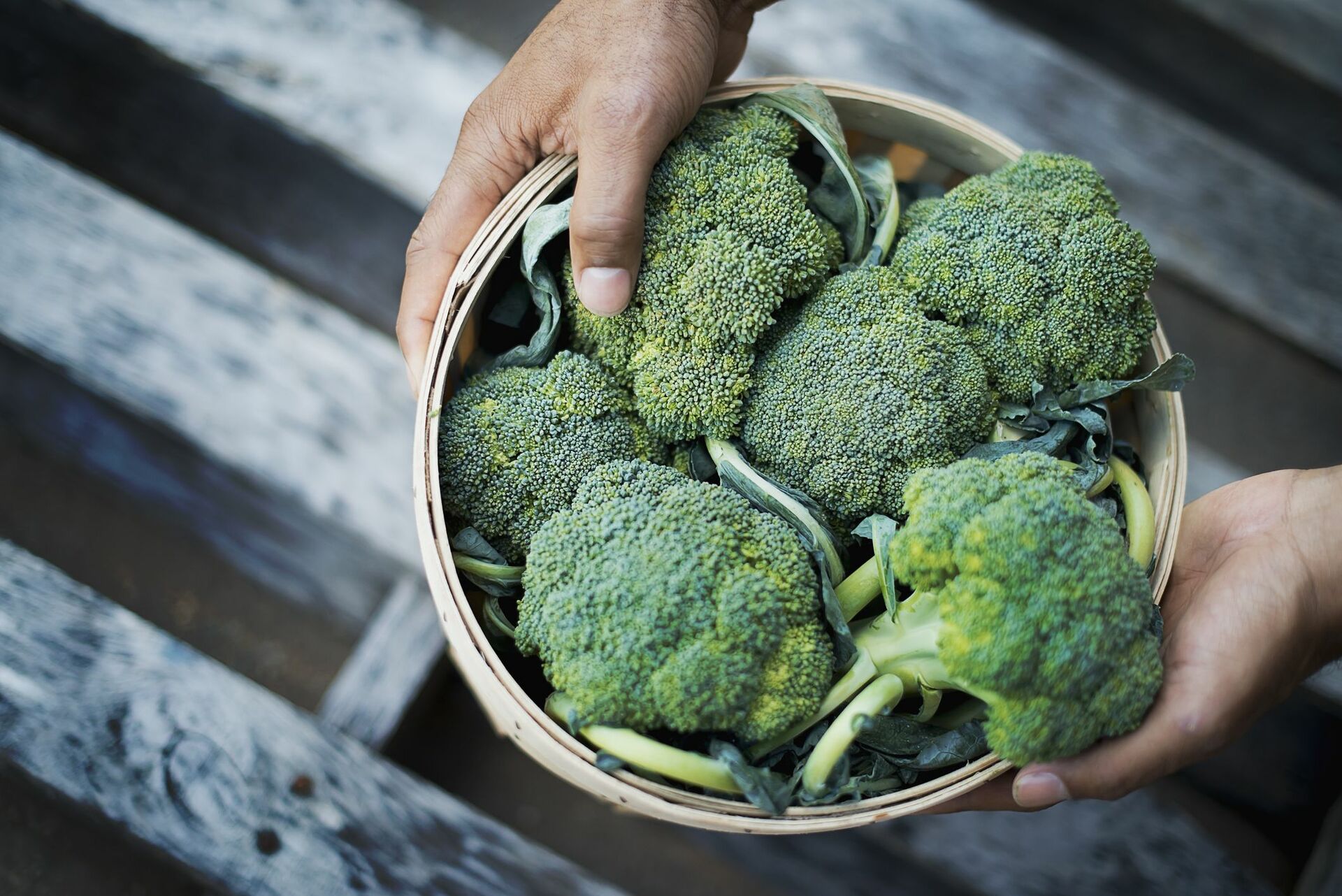

FAQs
Why Does Garlic Make You Fart
Modified: August 5, 2023
Discover the answer to the commonly asked question "Why does garlic make you fart?" and learn more about general questions related to this topic.
(Many of the links in this article redirect to a specific reviewed product. Your purchase of these products through affiliate links helps to generate commission for Under-tec.com, at no extra cost. Learn more)
Table of Contents
Introduction
Garlic, known for its pungent aroma and distinct flavor, is a widely used ingredient in cuisines around the world. However, it is also notorious for its ability to cause flatulence or, more commonly known as farting. If you’ve ever experienced the embarrassing and sometimes uncomfortable consequence of consuming garlic, you may have wondered why it happens.
In this article, we will delve into the science behind why garlic can make you fart. We will explore the composition of garlic, the digestive process, the role of sulphur compounds, the influence of gut bacteria, and other factors contributing to the production of gas.
But first, let’s get to know garlic a little better.
Garlic, scientifically known as Allium sativum, is a member of the onion family. It has been used for centuries not only as a culinary ingredient but also for its potential health benefits. Garlic contains several bioactive compounds, including vitamins, minerals, and organosulfur compounds, that contribute to its various effects on the human body. These compounds are released when garlic is crushed or chopped, activating its distinctive odor and taste.
Now that we have a basic understanding of garlic’s composition, let’s explore how it interacts with the digestive system and why it can lead to flatulence.
The Composition of Garlic
Garlic is packed with beneficial nutrients and bioactive compounds that contribute to its unique flavor and potential health benefits. Let’s take a closer look at the composition of garlic and the compounds that make it a culinary staple.
Garlic contains several essential vitamins and minerals, including vitamin C, vitamin B6, selenium, and manganese. These nutrients play important roles in supporting the immune system, regulating metabolism, and maintaining overall health.
However, what sets garlic apart from other vegetables are the organosulfur compounds it contains. These compounds are responsible for garlic’s pungent aroma and many of its health benefits.
One of the key organosulfur compounds found in garlic is allicin. Allicin is released when garlic is chopped, minced, or crushed. It has been shown to have antimicrobial, antioxidant, and anti-inflammatory properties. However, allicin is unstable and quickly degrades into other compounds, such as diallyl disulfide and diallyl trisulfide.
In addition to allicin, garlic also contains a compound called S-allyl cysteine (SAC). SAC is formed during the aging process of garlic and is relatively stable. It has been studied for its potential health benefits, including its role in reducing cholesterol levels and supporting cardiovascular health.
These compounds, along with other sulfur-containing compounds like ajoene and allyl mercaptan, contribute to the distinct flavor and potential health effects of garlic.
Now that we have a better understanding of the composition of garlic, let’s explore how it interacts with our digestive system and why it can lead to flatulence.
Digestive Process and Garlic
When we consume garlic, it undergoes a complex process in our digestive system, starting from our mouth all the way to the large intestine. Understanding this process can shed light on why consuming garlic can sometimes lead to flatulence.
When we chew or crush garlic, it releases enzymes that break down its compounds, particularly the sulfur-containing ones. As we swallow, the garlic enters the stomach, where it encounters stomach acid and further enzymatic breakdown.
From the stomach, the partially digested garlic moves into the small intestine, where the majority of nutrient absorption takes place. The small intestine is lined with specialized cells that absorb nutrients and move them into the bloodstream.
During the absorption process, some of the sulfur compounds in garlic can be broken down and metabolized by enzymes and gut bacteria in the small intestine. These metabolites can then be transported into the bloodstream and distributed throughout the body.
However, not all the sulfur compounds are absorbed in the small intestine. Some of them reach the large intestine, where they encounter a diverse population of gut bacteria. These bacteria play a crucial role in the final breakdown and fermentation of undigested carbohydrates and other compounds.
The breakdown of sulfur compounds by gut bacteria can produce a variety of gases, including hydrogen sulfide, methane, and carbon dioxide. These gases can accumulate in the intestines, resulting in bloating and flatulence.
It’s important to note that not everyone will experience flatulence after consuming garlic. The severity and frequency of flatulence can vary depending on individual factors such as gut bacteria composition, digestive enzyme activity, and overall gut health.
Now that we have explored the digestive process of garlic, it’s time to dive deeper into the role of sulfur compounds and gut bacteria in causing flatulence.
Sulphur Compounds in Garlic
Sulphur compounds are one of the key components of garlic that contribute to its distinct aroma and flavor. These compounds are also responsible for some of the potential health benefits associated with garlic consumption. However, they can also play a role in causing flatulence.
As mentioned earlier, when garlic is crushed or chopped, it releases an enzyme called allinase, which triggers the formation of allicin. Allicin, classified as a thiosulfinate, is a volatile compound that contains sulphur. It is responsible for the characteristic smell and taste of freshly cut garlic.
While allicin is initially formed upon garlic consumption, it is highly unstable. It undergoes rapid chemical transformations that result in the production of other sulfur-containing compounds, such as diallyl disulfide and diallyl trisulfide.
These sulfur compounds can cause a range of effects in the body, including stimulating the production of gas in the intestines. When these compounds reach the large intestine, they encounter the diverse population of gut bacteria that thrive there.
Gut bacteria play a crucial role in breaking down and fermenting undigested carbohydrates and sulphur-containing compounds. This fermentation process can produce gases, including hydrogen sulfide, methane, and carbon dioxide.
These gases accumulate in the intestines, leading to bloating and flatulence. The production and release of these gases vary from person to person, depending on factors such as gut bacteria composition and enzyme activity.
It’s important to note that not all sulphur compounds in garlic contribute to flatulence. For example, S-allyl cysteine (SAC), which is formed during the aging process of garlic, is relatively stable and is not involved in gas production. Therefore, consuming aged garlic supplements or aged garlic itself may result in less flatulence compared to consuming raw garlic.
While sulphur compounds in garlic can cause digestive discomfort, it’s worth mentioning that they also have numerous potential health benefits. These compounds have been studied for their antimicrobial, antioxidant, anti-inflammatory, and cardiovascular effects.
Now that we have explored the role of sulphur compounds in garlic, let’s examine the fascinating relationship between garlic and gut bacteria and how it affects flatulence.
Gut Bacteria and Garlic
Our gastrointestinal tract is home to trillions of bacteria, collectively known as gut microbiota. These bacteria play a crucial role in digestion, immune function, and overall gut health. When it comes to garlic and flatulence, gut bacteria play a significant role in the breakdown and fermentation of sulfur compounds in garlic.
In the large intestine, the sulfur compounds in garlic are exposed to a diverse population of gut bacteria. These bacteria have various enzymes that can metabolize the sulfur compounds, leading to the production of gases such as hydrogen sulfide, methane, and carbon dioxide. The type and abundance of gut bacteria can influence the amount and types of gases produced.
Research has shown that individuals with a higher abundance of sulfur-reducing bacteria in their gut may produce more hydrogen sulfide gas, which has a characteristic smell of rotten eggs. On the other hand, those with a higher abundance of methanogenic bacteria may produce more methane gas, which is odorless.
It’s worth noting that the composition of gut bacteria is highly individualized and can vary significantly from person to person. Factors such as diet, genetics, age, and overall gut health can influence the diversity and abundance of gut bacteria.
Interestingly, studies have shown that regular consumption of garlic can have a prebiotic effect on the gut microbiota. Prebiotics are compounds that promote the growth and activity of beneficial bacteria in the gut. Garlic contains certain types of carbohydrates, known as fructans, that act as prebiotics and can selectively stimulate the growth of beneficial bacteria.
However, while garlic can positively influence the gut microbiota, it can also lead to an overgrowth of sulfur-reducing bacteria in some individuals. This can result in increased gas production and flatulence. It’s important to point out that the impact of garlic on gut bacteria varies from person to person, and not everyone will experience excessive flatulence after consuming garlic.
It’s also worth mentioning that the combination of sulfur compounds from garlic and the fermentation activity of gut bacteria can produce a distinct odor in flatulence. This odor can be particularly strong and unpleasant due to the presence of hydrogen sulfide and other sulfur-related gases.
As researchers continue to investigate the intricate relationship between garlic and gut bacteria, more insights into the mechanisms behind flatulence and potential strategies to minimize its occurrence may emerge.
Now that we understand how gut bacteria interact with garlic, let’s explore the process of fermentation and gas production in more detail.
Fermentation and Gas Production
When the sulfur compounds from garlic reach the large intestine, they encounter a diverse community of bacteria that specialize in fermentation. This process involves breaking down undigested carbohydrates and sulfur compounds, resulting in the production of various gases.
Gut bacteria have enzymes that can metabolize the sulfur compounds present in garlic. As they break down these compounds, gases such as hydrogen sulfide, methane, and carbon dioxide are released. These gases can accumulate in the intestines, leading to bloating, discomfort, and, of course, flatulence.
The production and release of these gases can vary from person to person, depending on factors such as gut bacteria composition, enzyme activity, and overall gut health. Individuals with a higher abundance of sulfur-reducing bacteria may produce more hydrogen sulfide gas, which has a characteristic smell of rotten eggs. On the other hand, those with a higher abundance of methanogenic bacteria may produce more methane gas, which is odorless.
It’s important to note that fermentation and gas production are natural processes that occur in the gut. In fact, the production of gases is a byproduct of the metabolic activity of gut bacteria. However, excessive gas production can lead to discomfort and embarrassment, particularly when it comes to flatulence.
In addition to sulfur compounds, undigested carbohydrates can also contribute to gas production. Garlic contains certain types of carbohydrates, such as fructans, that are not fully digested in the small intestine. These undigested carbohydrates provide a substrate for fermentation by gut bacteria, resulting in the production of gases.
It’s worth mentioning that garlic is not the only food that can cause flatulence. Many other vegetables, legumes, and high-fiber foods can also contribute to gas production due to their composition and interactions with gut bacteria.
While flatulence from garlic consumption can be a temporary inconvenience, it is generally harmless. However, if excessive gas and discomfort persist or are accompanied by other symptoms, it’s advisable to consult a healthcare professional for further evaluation.
Now that we understand the fermentation process and gas production, let’s explore some ways to reduce flatulence from garlic consumption.
Other Factors Affecting Flatulence
While garlic consumption is often linked to flatulence, it’s important to recognize that multiple factors can contribute to the extent and frequency of gas production. Here are a few additional factors that can influence flatulence:
Individual Sensitivity: Each individual has a unique digestive system and may have different tolerances to certain foods. Some people may be more sensitive to the sulfur compounds in garlic, while others may experience minimal or no flatulence at all.
Dietary Habits: The overall composition of one’s diet can impact flatulence. Consuming a diet high in fiber, especially fermentable fibers found in fruits, vegetables, and whole grains, can lead to increased gas production. Combining garlic with other gas-producing foods can further exacerbate flatulence.
Eating Habits: Eating too quickly, not chewing food thoroughly, or swallowing air while eating can also contribute to the accumulation of gas in the digestive tract. It’s important to chew food slowly and mindfully to aid in digestion and minimize the risk of excessive gas formation.
Overall Gut Health: The health of the digestive system and the balance of gut bacteria can influence the extent of gas production. Conditions such as small intestinal bacterial overgrowth (SIBO) or imbalances in gut flora can lead to increased gas production and flatulence.
Preexisting Conditions: Certain medical conditions, such as irritable bowel syndrome (IBS) or food intolerances, can make individuals more susceptible to flatulence. These conditions can affect the way the digestive system processes certain foods, including garlic.
Preparation and Cooking Methods: The way garlic is prepared and cooked can affect its impact on flatulence. For example, roasting or baking garlic can make it more tolerable compared to eating it raw. Cooking methods can help break down some of the sulfur compounds and make them less potent.
It’s important to note that while avoiding garlic altogether may help reduce flatulence, it may also mean missing out on the potential health benefits associated with garlic consumption. Finding the right balance and experimenting with different cooking methods and portion sizes can help minimize flatulence while still enjoying the flavors and potential health benefits of garlic.
Now that we have explored the various factors that can affect flatulence, let’s move on to some strategies to reduce flatulence from garlic consumption.
Ways to Reduce Flatulence from Garlic Consumption
If you enjoy the taste and potential health benefits of garlic but want to minimize the associated flatulence, there are several strategies you can try. While the effectiveness of these methods may vary from person to person, they can potentially help reduce the extent and frequency of gas production:
1. Cooking Methods: Opt for roasted or baked garlic instead of consuming it raw. Cooking can help break down some of the sulfur compounds present in garlic, making it easier to digest.
2. Fermentation: Fermenting garlic can alter its composition and reduce its gas-producing potential. This process involves storing garlic in vinegar or fermenting it in brine, which can help mellow the flavors and reduce the sulfur content.
3. Garlic Supplements: If you still want to obtain the potential health benefits of garlic without the flatulence, consider trying aged garlic supplements. These supplements are made from aged garlic extracts, which have a milder flavor and reduced gas-producing properties compared to raw garlic.
4. Portion Control: Moderation is key when it comes to garlic consumption. Start with smaller amounts and gradually increase as tolerated. This allows your digestive system to adapt and reduces the risk of excessive gas production.
5. Be Mindful of Pairings: Certain foods can exacerbate flatulence when combined with garlic. Foods such as beans, lentils, cabbage, and onions are known for their gas-producing properties. Consider cooking garlic with other ingredients that are less likely to cause excessive gas production.
6. Digestive Aids: Digestive aids such as probiotics or enzyme supplements may help support digestive health and reduce the discomfort associated with flatulence. Consult with a healthcare professional to determine if these supplements are appropriate for you.
7. Soaking and Peeling: Soaking garlic cloves in water for a brief period and removing the outer skin may help reduce the sulfur content and make it more tolerable for digestion.
8. Slow and Thorough Chewing: Take your time to chew garlic thoroughly. Chewing aids in the digestion process and can help break down the sulfur compounds before they reach the large intestine.
9. Monitor and Adjust: Keep track of your garlic consumption and how it affects your flatulence. Experiment with different cooking methods, portion sizes, and combinations with other foods to find what works best for you.
Remember, everyone’s digestive system is unique, and what may work for one person may not necessarily work for another. It may take some trial and error to find the right approach to enjoy garlic while minimizing flatulence.
By implementing these strategies and being mindful of your body’s response, you can potentially reduce flatulence while still incorporating garlic into your diet.
Conclusion
Garlic is a versatile and flavorful ingredient that adds a distinct taste to various dishes. However, for some individuals, consuming garlic can lead to the uncomfortable and embarrassing side effect of flatulence. Understanding the factors that contribute to flatulence from garlic consumption can help alleviate this issue while still enjoying the potential health benefits of garlic.
Garlic contains sulfur compounds that undergo transformation and fermentation in the digestive system. These compounds can interact with gut bacteria, leading to the production of gases such as hydrogen sulfide, methane, and carbon dioxide. The extent of gas production varies among individuals and can be influenced by factors such as gut bacteria composition, overall gut health, and individual sensitivities.
Reducing flatulence from garlic consumption can be achieved through various methods. Cooking garlic, fermenting it, or opting for aged garlic supplements can help reduce the gas-producing properties. Portion control, mindful pairings with other foods, and the use of digestive aids or supplements may also prove beneficial. It’s important to listen to your body, monitor your response to garlic consumption, and make adjustments accordingly.
While flatulence may be an inconvenience, it’s worth noting that it is generally harmless. If excessive gas and discomfort persist or are accompanied by other concerning symptoms, it’s advisable to consult a healthcare professional for further evaluation.
In conclusion, understanding the factors influencing flatulence from garlic consumption and implementing strategies to reduce its occurrence can help individuals enjoy the flavors and potential health benefits of garlic while minimizing digestive discomfort. With experimentation and mindful consumption, you can confidently embrace garlic as a culinary ingredient and harness its potential benefits without the worry of excessive flatulence.










